Why Australian-grown coffee is creating a buzz (plus eight to try)
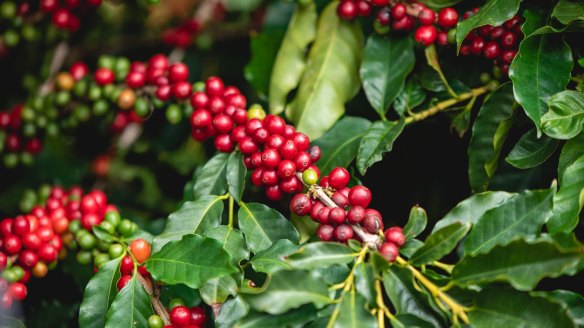
The pandemic, global warming and changing consumer trends are throwing a spotlight on Australian-grown coffee. How do our beans (and the industry that produces them) stack up?
When archaeologists recently dug up 167-year-old imported coffee beans under Melbourne's Young & Jacksons pub (in preparation for Metro Tunnel works), Victoria's deputy premier quipped that it proved "coffee has long been important to Melburnians". But coffee grown in Australia – and our relationship to it – goes back even further.
Coffee seeds arrived with the First Fleet but the first recorded coffee tree planting was at Kangaroo Point, Brisbane, in 1832.
Remarkably, Australia was almost self-reliant from the 1880s to the early 1920s, with up to 60 producers growing about 40 per cent of coffee consumed here. (Some beans even won awards in Paris and Rome, according to Filtered: Coffee, the Cafe and the 21st Century City by Dr Emma Felton.)
The Great Depression, soaring labour costs and Australia's vast, transport-unfriendly size killed off the industry until the 1980s, when a few pioneers began replanting and developing game-changing mechanised harvesting techniques.
Australian coffee would appeal to anyone. It's not too strong or overly fruity. It's just a nice balanced cup.John Russell Storey
Fast forward to today and about 50 coffee plantations – mostly in Far North Queensland and north-east New South Wales, with a few in south-east Queensland – produce less than 1 per cent of coffee consumed in Australia (about 600 tonnes of green beans each year from 850,000 trees). While that doesn't sound much, the quality of these arabica beans is generally high, with low food miles and minimal pesticide use an added selling point.
But recent disruptions, including frosts in Brazil, international supply chain issues to do with pandemic and war, and ongoing issues caused by climate change, have sparked uncertainty around imported coffee, and prices are likely only headed up.
Which makes us wonder: what kind of shape is the Australian-grown coffee industry in, and could it save us?
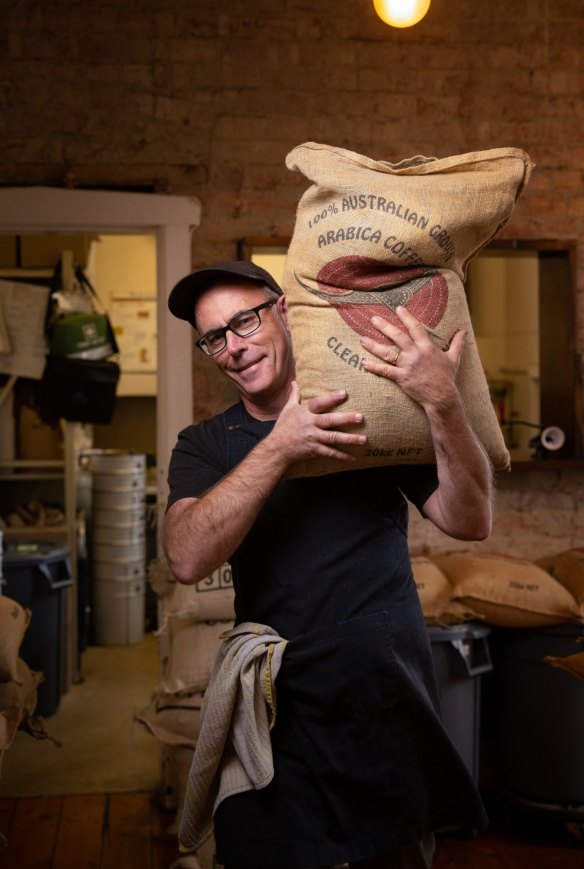
Mark Ryan (pictured above), owner of Growers Espresso in Fitzroy North, has spent more than 20 years in coffee. He chucked in his Parks Victoria job to research coffee roasting and selling when his wife's parents moved to the Byron Bay hinterland to grow coffee in the late 1990s.
The brand they created, Eureka Coffee, blossomed and although his in-laws have since retired, Ryan continues to source Australian-grown beans, primarily from a plantation called Mountain Top Coffee, in northern NSW.
Despite being able to access consistently good beans (Mountain Top scored 92.25 and a gold medal in last year's Sydney Royal Fine Food Show), Ryan says the industry is facing multiple challenges.
First, there's price. Australian-grown specialty coffee generally compares favourably with imported beans but tends to retail at the higher end of the spectrum.
"It's an expensive crop to produce in Australia for a number of reasons," Ryan says. "One being our labour costs and the costs that go into running any business, [but] also the costs of land."
Adding to this pressure recently is a generation of coffee farmers who are retiring and selling their plantations to farmers growing other crops or to lifestyle buyers with no interest in farming.
Just out of Nimbin, Mountain Top Coffee's process manager and roaster Bernard Rooney says new owners there recently reduced their coffee trees from about 80,000 to 45,000 to make way for avocados.
Rooney, who started as a casual in 2006, believes the industry is interestingly poised. "I suppose it's about where the younger generation want to go with it," he says. "People drink coffee, but the global market seems to be closing down on us – prices doubling, shipping costs, etcetera.
"So, I'm hoping for a bit of a surge, but I think on a small scale, with small farms."
Jack Murat, a relatively new Australian coffee plantation in tropical Far North Queensland, is an example of where the industry could be headed. Located an hour's drive west of Cairns in Mareeba, an established coffee-growing area on the Atherton tablelands, this family-run farm was established in 1929 by Albanian migrant Hymet "Jack" Murat. After growing tobacco and other crops for many years, Jack's three sons Plum, Paul and Ben, teamed up with the family's next generation and decided to plant coffee in 2014.
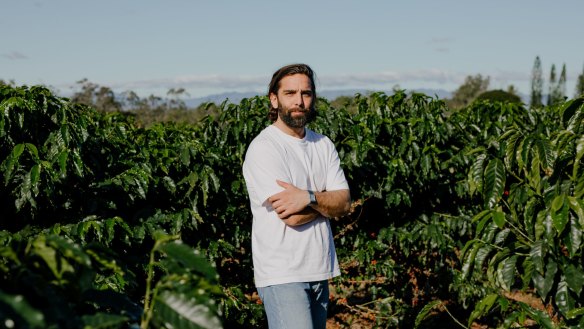
Spearheading the injection of youth is Ben Murat's son, Jemal, 35. With a commerce degree, Jemal's vision for the brand takes inspiration from successful Australian wine producers – it's about quality, terroir, elegant design and good marketing to ensure you control the product right through to the first sip. This is one of the reasons Jack Murat is working with independent Sydney roaster Nic Theodore (ex-Reuben Hills) and Melbourne roasters Zest.
"Often the farmer will focus solely on their farming components and will leave all the forward-facing aspects to the roasters," says Jemal. "So, the chain is perhaps broken because the producer isn't the one representing themselves. I want to ensure that we, as producer, are representing ourselves."
Jack Murat coffee is already available to buy online but Jemal has plans to open a dedicated metro roastery and cafe in the next 12 to 18 months. He also believes they are on track to become the largest producer of specialty coffee in Australia.
"My vibe is extremely positive," he says of the outlook for Australian-grown coffee. "And it's almost less about coffee and more about the underlying sort of ethos that people are seeking. I think people are seeking local. And that goes across the board when it comes to produce."
Jemal's emphasis on local, quality and modern branding encourages Rebecca Zentveld, an award-winning industry veteran grower and roaster at Zentveld's Coffee in near Byron Bay and president of the newly renamed Australian Grown Coffee Association.
"We need to grow like the wine industry, add value to our crop, and meet the expectations of the next generation of coffee drinkers, who are environmentally conscious and have a sophisticated radar for good design and authentic storytelling," says Zentveld.
But it's not just fresh faces the industry needs. A recent coffee growers' strategy plan commissioned by the Australian Government-funded AgriFutures made several recommendations on how to keep the industry healthy.
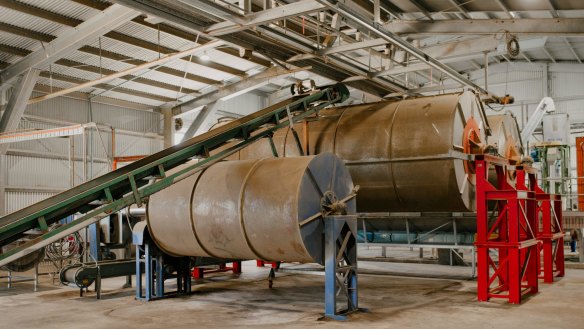
These included investment in better processing (washing, drying, hulling and colour sorting – a key to ensuring quality), creating regional identities (similar to the wine industry), creating a centralised information system (through the Australian Grown Coffee Association), planting more trees to respond to consumer demand and, finally, making a new semi-dwarf variety available (commercial cultivars K7 and Catuai favoured in Australia grow too vigorously and require labour-intensive and yield-disrupting pruning to allow machine harvesting).
Work on that last issue is now well under way in Alstonville, NSW, where an AgriFutures-funded World Coffee Research trial of 25 varietals from 10 countries is in its third year.
"It's exciting," says the trial's manager, Tobias Kretzschmar, an associate professor of plant breeding and genetics at Southern Cross Plant Science in Lismore.
He believes that a variety that yields good-quality beans and can be machine-harvested is what is truly holding the industry back.
Meanwhile, as climate change puts added disease pressure on overseas trees, Australia's unique pest and disease-free status could see us become a "living seedbank" for all the world's coffee varieties.
"You can't store coffee beans, because after a couple of years they won't grow anymore," says Kretzschmar. "Since we're free of diseases, we're pitching ourselves to become a safe haven for coffee."
He predicts that due to climate change and other supply disruptions, coffee prices are likely to keep rising. This might make Australian coffee more attractive, particularly if new varieties can reduce production costs.
"I think there's a very big opportunity for growth of Australian coffee. And it also has to do with Australian consumers realising the value of supporting local industries and becoming a bit independent. Australians can't go without coffee. We're some of the world's biggest coffee lovers."
But finally, how does Australian coffee really stack up against imported beans?
Interestingly, research carried out in 2012 by Southern Cross Plant Science showed that Australian-grown coffee was on average up to 30 per cent lower in caffeine than a selection of imported beans. Many believe this is largely due to the lack of pests here – caffeine is produced by coffee trees as a natural defence mechanism.
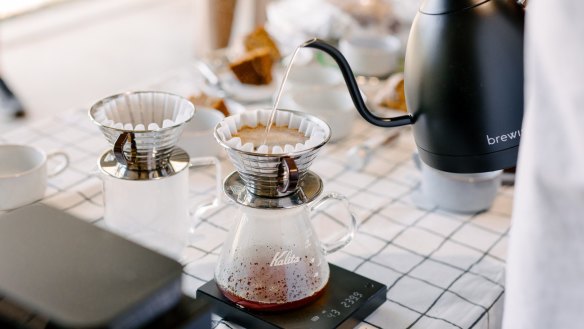
But what about the flavour?
John Russell Storey, a seasoned professional who tastes between 800 and 1000 coffees each year for Cofi-Com, one of Australia's largest coffee bean importers, says well-processed Australian coffee stacks up "surprisingly well" and is close in flavour to a good grade Brazil bean.
"It's what we describe as soft," says Russell Storey. "A little bit of mildness, but there's a lot of chocolate in there and a nice bit of fruitiness. It's one of those coffees that would appeal to anyone. It's not going to frighten them away with being way too strong or overly fruity. It's just a nice balanced cup."
And, with rumours a competitor is planning to wow judges with an Australian-grown coffee at the upcoming Melbourne International Coffee Expo's World Brewers Cup (September 27-30, see internationalcoffeeexpo.com), it might be advisable to buy local before the rest of the world catches on.
Peter Barrett travelled to Queensland as a guest of Jack Murat.
Eight Australian-grown coffees to try
Mountain Top Coffee, Nimbin, NSW
For lovers of plunger coffee, try the freshly roasted Bundja. Beans are allowed to stay longer on the tree to ripen and ferment slightly. A mechanised drying process helps deliver a fruity and intense cup with a good body.
$12.50 for 250g, mountaintopcoffee.com.au
Zentveld's Coffee, Northern Rivers, NSW
Expect complex flavours and dried fruit from Zentveld's single farm blend, Zero Miles. A mix of washed and natural process beans picked exclusively on their plantation in the hills behind Byron Bay, it's perfect for espresso, with or without milk.
$15 for 200g, zentvelds.com.au
Jack Murat, Mareeba, Far North Queensland
This new player on the scene's Catuai Rojo is a washed process single origin arabica that works for filter, plunger or espresso. Look for milk chocolate and lemon flavours with a clean finish. Also available in coffee pod format.
250g for $17 or 10 capsules for $12, jackmurat.com
Skybury, Mareeba, Far North Queensland
One of Australia's oldest plantations and a big exporter, Skybury's House Roast is a blend of medium and medium-dark roast, perfect for milk-based coffee. Expect a buttery chocolate taste with a hint of lime and rich mouth feel.
250g for $15, skybury.com.au
Jacques, Mareeba, Far North Queensland
Pioneers of the mechanical coffee harvester, Jacques' popular Espresso Roast is a blend of medium and medium-dark roasted, hand-selected green beans. Expect hints of chocolate, honey, vanilla and caramel, suitable for espresso, strong plunger, strong drip filter or pourover.
250g for $15, jacquescoffee.com.au
Byron Blue, Northern Rivers, NSW
Grown, processed and roasted on site in the Byron Bay hinterland, this single origin bean called Australian Byron Blue should present clean and smooth with a marshmallow sweetness, rich dark chocolate and floral finish.
250g for $22, buncoffee.com.au
Kahawa Estate Coffee, Northern Rivers, NSW
Choose from medium-bodied Lava with its sweet and tangy finish for plungers, drip filters and percolators or the medium-dark roasted Magma, best suited for espresso machines or stovetop coffee pots.
Both 225g for $12.50, kahawaestate.com.au
Eureka, Melbourne, VIC
Based in Fitzroy North's Growers Espresso coffee shop, Mark Ryan roasts Mountain Top Coffee each week to create blends of Australian-grown coffee suitable for different coffee styles. Try the Premium Espresso Roast for sweet rich chocolate, marzipan and marmalade flavours.
250g for $18, eurekacoffee.com.au